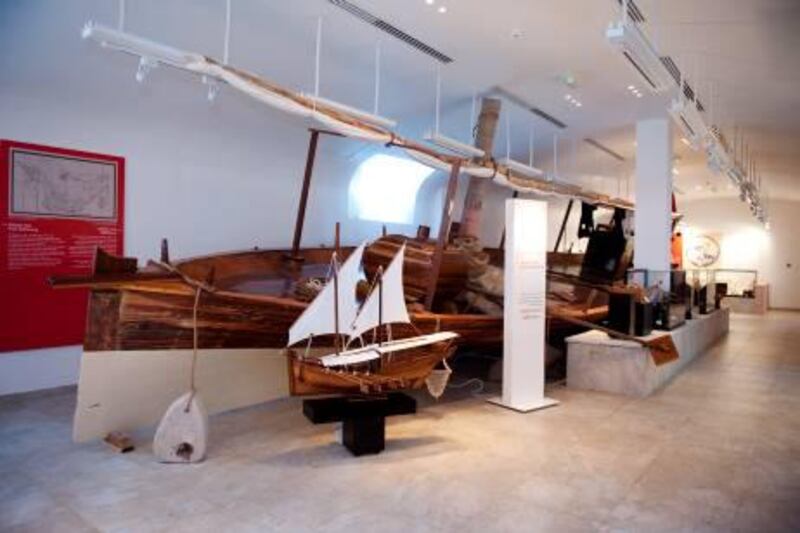RAS AL KHAIMAH // There are many ancient myths about the precious pearl, but two local legends say she has two mothers.
One says she is Bint Al Matar' daughter of the rain, conceived when the oyster shell captured a single sweet drop of precipitation before mixing it with the salty sea.
The other claims she is Bint Al Qamar, daughter of the moon, born during a full moon after the oyster swam to the water's surface and captured a single dew from the silvery ray.
Everything from the legends surrounding the pearl, its history as a treasure sought by merchants and monarchs across the world, its impact on the local culture and economy, and where it stands today in the modern world, can be found inside the new RAK Pearls Museum.
"Whether born out of the moon or out of the rain, there is nothing more beautiful or precious than a pearl," said Mohamed Al Suwaidi, the museum's excursion operation manager.
His passion for these little treasures is evident in the string of yellow-white prayer pearls he holds in his right hand, as he gives a tour of the museum.
"RAK, which was historically known before as Julfar, was the capital of pearl trading as evident from old documents by European travellers and sailors," said Mr Al Suwaidi.
He points to a replica of a document dated 1654, from the governor general in Batavia (Jakarta, Indonesia) to directors of the Dutch East India company in the Netherlands. It asks the company to send "two energetic and experienced merchants" to Julfar, where "this jewel is being fished, to stay there from the first to the last catch".
"So it made sense to open a museum here, solely dedicated to the pearl and its revival," Mr Al Suwaidi said.
The centuries-old pearling industry collapsed in the Gulf in the early 1930s with the Japanese invention of cultured pearls. Natural pearls occur in oysters without human intervention. Cultured pearls are created when the tissue of a donor oyster and a bead are artificially inserted into the shell. This practice rendered the dangerous occupation of pearl diving obsolete.
Regardless of the pearling industry's fate, the influence of the pearl lived on, as Emirati women are still being named after different types of local names for pearls, such as Dana, Hessa, Moza and Qemasha.
The museum, which is one of a kind in the region, opened two months ago as part of a soft launch on the Al Qawassim Corniche.
Upon entering the museum, a visitor is transported into a different world, surrounded by a distinct interior design of thousands of shimmering empty oyster shells along the walls.
"We waste nothing, we use every bit of the oyster shell after we take out the pearls. Its shells for design, its edible interiors as food and whatever is left as fertiliser for our crops," Mr Al Suwaidi said.
The museum belongs to RAK Pearls Holding, a company that has been farming cultured pearls since 2005 in the Al Rams creek area of RAK. The thousands of local pearls, which come in different shapes, sizes and colours, are on display were all born in Rak's waters.
Mahra Al Zaabi, the museum's director, and Fatima bin Tameem, the museum's tour guide, help to manage the two-storey museum with great enthusiasm.
On the first floor is a historical journey, including a detailed showcase of tools and gear worn by pearl divers, such as 'Al Khabt', or leather finger gloves; 'Al Fatam', a tortoise-shell flexible nose clip; and a thick, white cotton diver suit against jellyfish.
The divers had rubbed oil, known as 'Al Gre'at', all over their bodies. The oil was made of Acaci berry and water mixed inside a dried up coconut container.
"Their skin couldn't survive without this moisturiser," said Mr Al Zaabi. Despite this precaution, many divers suffered from great illness later on in their life.
"They wore no protection for their eyes and ears, and suffered later on from blindness and deafness," said Mr Al Zaabi. "It was really hard work and many suffered and even died on the job."
One of the last surviving pearl divers, Faraj Al Muhairbi, in his 70s, also comes to the museum and takes out visitors on a pearl-diving experience on a dhow.
The 40-metre-boat, called a 'jalbout', includes everything a pearl diver needed, from an oven to a cannon that would be fired to signal the return of divers from a four-month and 10-day diving season in the summer.
"They had a designated singer, and took with them drums, and 'Al Narjeelah', an early form of shisha, to keep themselves entertained," said Mr Al Zaabi.
In addition to photographs of "Ama divers" - traditional Japanese female divers - the museum's second floor is lined with displays of the world's famous pearls, and instruction on how to distinguish natural and cultured pearls.
There are small, 10mm, white-and-beige Akoya pearls, and larger, black-lipped pearls (reaching 16mm). There are popular freshwater mussel pink pearls pioneered by China and Japan that account for 95 per cent of the world's total production of freshwater pearls.
An oddity, Buddha oyster shells are also on display. They come from an 11th-century Chinese technique in which statues of the Buddha were placed inside oysters in hopes that each shell would be blessed with a pearl. Instead, imprints of the statues were made inside the shells.
Last but not least is RAK's 12mm "Miracle of Arabia" pearl, sitting on a red velvet throne inside the museum.
Certified by the Swiss Gemmological Institute (SSEF), the 2007 born white pearl is "perfect".
"Look how perfectly round, thick and lustrous she is," Mr Al Suwaidi says. "This is our queen."






